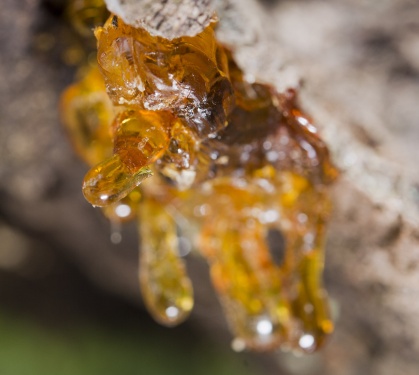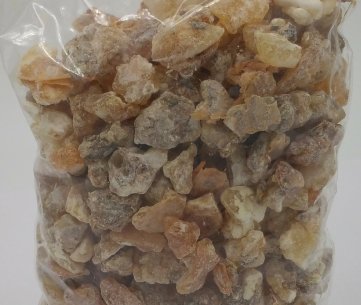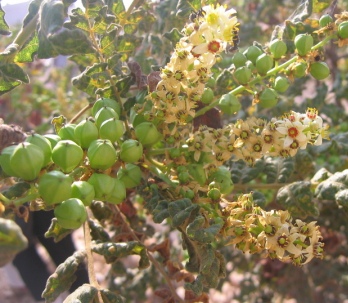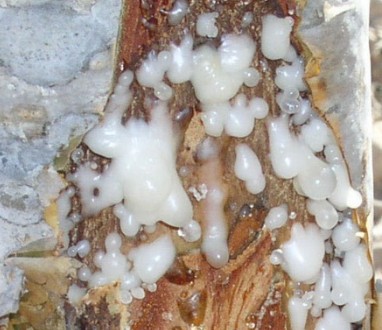-Essential-Oil.png)
-Essential-Oil.png)




Botanical name Boswellia frereana
Family Burseraceae
Source Resin
Origin Somalia
Processing Method Steam Distillation
Storage conditions: Store in air tight container; in a cool dry area; away from direct sunlight
Appearance: Colourless to Pale Yellow Liquid
Odour: Characteristic warm, spicy balsamic incense-like aroma
Solubility: Soluble in alcohol and oils, insoluble in water
Flash Point: 51 degrees Centigrade
Optical Rotation: +15° to -15°
Refractive Index: 1.460 to 1.490
Specific Gravity: 0.847 to 0.877
Aromatic Summary / Note / Strength of Aroma A base note with a medium aroma, Frankincense Essential Oil has a warm and spicy, woody odor that is haunting.
Blends With : Basil, Bergamot, Cardmom, Cedarwood, Chamomile, Cinnamon Bark, Clary Sage, Coriander, Geranium, Ginger,Myrrh and Vanilla.
Product Abstract
Frankincense originates from a small scraggly but hardy tree indigenous to the Middle East, which is small with abundant pinnacle leaves and white or pale pink flowers. The resin begins as a fragrant sticky milky-white liquid that flows from the trunk of the tree when cut. The dried tears are collected, and the resin is then distilled, producing the precious oil. The resin is known as olibanum, derived from the Arabic al-luban or 'that which results from milking', referring to the milky sap. It is used as incense, and has been traded for 5,000 years. Widely used in ancient Egypt, it was one of the ingredients used in the holy oil described in the Talmud. Frankincense was brought back to Europe by Frankish Crusaders (Frank-incense), and the oil is still highly prized today in the perfumery industry, and widely used in the manufacturing of skin-care products.
History
Frankincense has been traded on the Arabian Peninsula, in North Africa, and Somalia for more than 5000 years. A mural depicting sacks of frankincense traded from the Land of Punt adorns the walls of the temple of ancient Egyptian Queen Hatshepsut, who died circa 1458 BC.
Harvesting/Extraction Information
The Essential oil of frankincense is produced by steam distillation of the tree resin. The oil's chemical components are 75% monoterpenes, sesquiterpenes, monoterpenoles, sesquiterpenols and ketones. It has a good balsamic sweet fragrance, while the Indian frankincense oil has a very fresh smell. Contrary to what some commercial entities claim, steam or hydro distilled frankincense oils do not contain boswellic acids (triterpenoids), although may be present in trace quantities in the solvent extracted products
Common Usage
Caution
There are no known adverse side effects. That being said, frankincense essential oil should not be used during pregnancy, since it does act as an emenagogue and astringent.
Key constituents
a-Pinene 41.7–80.0%
Sabinene 0.5–21.0%
a-Thujene 0–19.3%
(þ)-Limonene 0–17.0%
Viridiflorol 0–15.2%
p-Cymene 0.7–11.7%
b-Pinene 0–6.9%
Verbenone 0–6.5%
b-Myrcene 0–6.0%
a-Phellandrene 0–5.9%
Bornyl acetate 0–5.6%
Carvone 0–4.4%
d-3-Carene 0–3.4%
Linalool 0–3.0%
1,8-Cineole 0–2.9%
g-Terpinene 0–2.5%
Camphene 0–2.1%
Thujol 0–1.8%
a-Pinocarveol 0–1.7%
Campholenic aldehyde 0–1.5%
Octyl acetate 0–1.5%
a-Terpinene 0–1.5%
b-Elemene 0–1.3%
b-Caryophyllene 0–1.2%
a-Thujone 0–1.2%
(Z)-b-Ocimene 0–1.0%
b-Phellandrene 0–1.0%
b-Selinene 0–1.0%